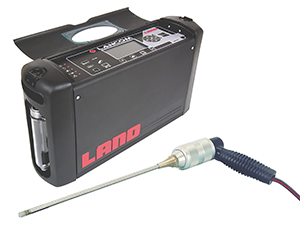

Measuring flue gases in industrial plants or power stations is essential for process control, efficiency and emissions monitoring. It is particularly important for combustion processes, where close control of the reaction is essential to improve safety and fuel economy as well as to reduce harmful emissions and operational costs.
Combustion control is accomplished by achieving the optimum ratio between fuel and air. Excess oxygen (from the air) reduces combustion efficiency and creates unwanted NOx emissions. However, insufficient oxygen conditions lead to incomplete combustion, which can result in a dangerous flameout condition.
Monitoring CO – which is created by incomplete combustion of the fuel – alongside the O2 measurement helps to optimise the fuel-to-air ratio. It also fulfils a safety role by safeguarding against CO accumulation, which represents an explosion hazard.
The Lancom 4 flue gas analyser, from Ametek Land, is an ideal solution for process control, including combustion, in many industrial plants. The highly accurate, robust, flexible, and portable instrument is applicable to any industry that burns coal, natural gas, oil or biomass, including power generation, paper, steel, glass and cement manufacturing.
This multi-gas analyser measures up to eight flue gases simultaneously, with nine separate sensors, in a range of combustion and emission processes. Using a combination of sensor types, all the major flue gases are monitored – electrochemical (for O2, CO, SO2, NO, NO2 and H2S), infrared (for CO2) and pellistor/catalytic (for hydrocarbon).
Simple to set up and easy to operate, the Lancom 4 provides highly accurate spot and semi-continuous gas testing. The analyser is customisable to specific measurements and process stream conditions, and is easy to maintain and service. It can be configured for a wide range of applications to ensure full, optimum combustion conditions, and compliance with emissions requirements.
A resilient stainless steel probe extracts the gas sample, while real-time processing techniques produce highly accurate combustion and emissions calculations. The standard probe is suitable for most applications and is available in lengths ranging from 0,3 to 3 m.
Powered by a long-life, eight-hour battery charge, the analyser is supported by automatic zero calibration and continuous system diagnostics to maintain excellent analytical performance throughout its operation. Robust and lightweight, it is easy to transport and use, and can be upgraded in the field with a simple configuration file installation.
The instrument supports combustion efficiency measurements for flue gases in the stack or duct. It is capable of measuring up to eight flue gases in a range of combustion and emissions processes, and provides simultaneous measurements for O2 and CO. These can also be combined with true NOx measurement (including both NO and NO2) and SO2 monitoring for emissions reduction and a hydrocarbons measurement to support safety.
The standard CO sensor is suitable for most purposes, but some applications require alternatives. A high-range CO sensor can measure concentrations up to 10%, which allows useful readings to be made even when a burner is far from correct operation, such as during boiler startup. Where both sensors are fitted, the Lancom 4 switches automatically between the high- and low-range sensors.
In cases where a significant concentration of hydrogen can be present, a hydrogen-compensated CO sensor improves accuracy by correcting for the cross-interference between the two species. This instrument also offers the capability to measure flue gas temperature and flow velocity, providing a greater understanding of combustion conditions.
Typically, in processes where combustion takes place, flue gas emissions must also be measured to prove compliance with restrictions on harmful pollutants entering the atmosphere. It can be costly for plants to operate separate analysers for combustion control and emissions monitoring.
However, in industrial plants with smaller processes, where there is a requirement to demonstrate compliance with air pollution regulations, the Lancom 4 is ideal for periodic emissions testing. Its portability and multi-gas capabilities mean that a single analyser can be used to measure emissions at different points in a process, or from different processes altogether. For example, in paper mills, large boiler houses are used to provide steam, with emissions monitoring often required on a shift basis. The Lancom 4 not only provides an economic solution to this, it also allows the opportunity to trim boiler controls for maximum efficiency and lower fuel costs.
The analyser meets a number of test protocols, including ASTM D6522 for nitrogen oxides (NOx), carbon monoxide and oxygen concentrations. It can also monitor species not commonly measured by CEMS, such as hydrocarbons and hydrogen sulphide. While not a substitute for CEMS, it provides a flexible solution for processes that do not require continuous monitoring, but must still comply with emissions regulations. By combining flue gas measurements for process control with multi-gas emissions monitoring capability, it provides a flexible, cost-effective solution for many industrial processes.
| Tel: | +27 11 918 6994 |
| Email: | [email protected] |
| www: | www.e-analytics.co.za |
| Articles: | More information and articles about Elemental Analytics |

© Technews Publishing (Pty) Ltd | All Rights Reserved